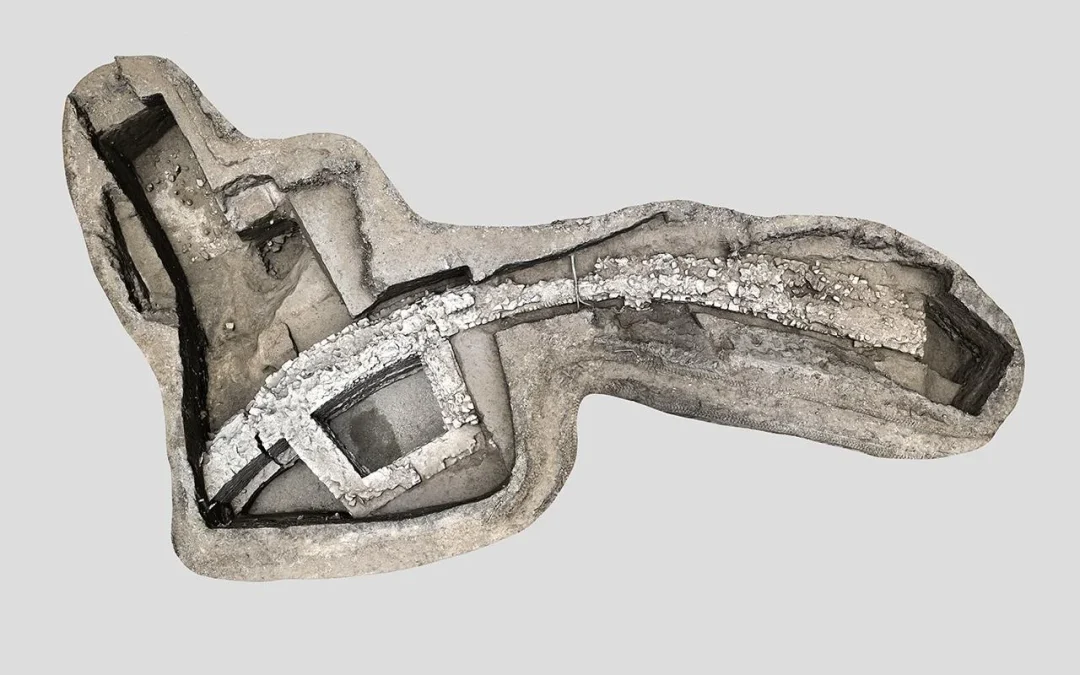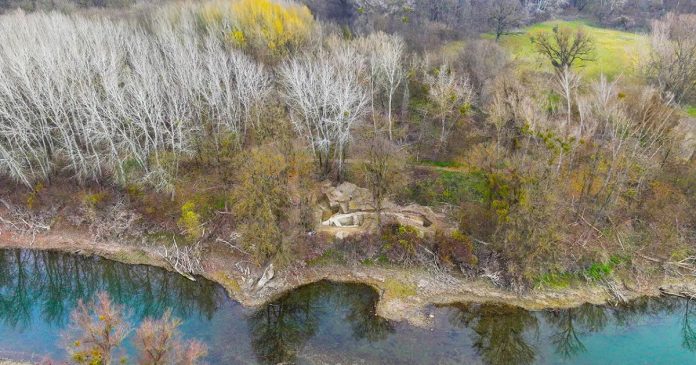Introduction: A Whisper from the Danube’s Edge
In the quiet embrace of Stopfenreuth, Austria, along a Danube tributary, stands a relic of time. Known as the Deserted Castle, its crumbling walls have long whispered secrets. For this reason, its been many years since locals speculated it was a medieval stronghold or a Turkish War outpost. Nevertheless, beneath these tales, a deeper truth waited. In the meantime, recent excavations by the Austrian Academy of Sciences have unveiled its identity. This is no castle but a Roman bridgehead fort, the first found in Austria. Finally, it was dated to the Marcomannic Wars, this discovery reshapes our view of the Roman Limes. Because of all this, I invite you to join us as we explore this ancient marvel, reflecting on its story and legacy.
Unveiling the Deserted Castle: A Roman Revelation
The Deserted Castle, near Stopfenreuth, has puzzled historians for decades. For instance, its location, four kilometers from Carnuntum, hinted at significance. In sum, Carnuntum was a legionary fortress and Pannonian fleet headquarters. It later became the capital of Pannonia Superior province. The structure’s purpose remained elusive until now. In addition, it was the Austrian Archaeological Institute, part of the ÖAW, led the recent digs. Their findings confirmed it as a bridgehead fort, built to secure river crossings. This marks the first such fort identified on Austrian soil, a historic milestone.
What Is a Roman Bridgehead Fort?
Bridgehead forts were strategic Roman military outposts. They controlled key river crossings or access routes across frontiers. These strongholds served as forward bases for Roman campaigns. Positioned on the enemy’s side of a river, they ensured safe passage. Furthermore, they also launched offensives against neighboring tribes. The Stopfenreuth fort, on the Danube’s north bank, fits this role. It protected a vital crossing during a volatile era. For the most part, the Danube marked the Roman Empire’s frontier, known as the Limes. Above all, this fort was a bulwark against Germanic tribes beyond.
A Timeline Forged in Conflict: The Marcomannic Wars
In brief, the fort dates to the Marcomannic Wars, spanning AD one hundred sixty-six to one hundred eighty. At the same time that this lands saw fierce battles along the Danube frontier. For this reason, Emperor Marcus Aurelius led Rome against the Marcomanni and other Germanic tribes. The wars were a defining moment for the Roman Limes. Accordingly, archaeologists identified two construction phases at Stopfenreuth. The first, between AD one hundred seventy and one hundred eighty, aligns with Marcus Aurelius’s reign. He expanded fortifications to secure the frontier during the conflict. In the same way, the second phase, around AD two hundred sixty, reflects Emperor Gallienus’s efforts. Moreover, Gallienus reinforced defenses amid renewed threats, ensuring Rome’s hold.
Evidence from the Earth: Unearthing Roman Legions
Excavations at Stopfenreuth revealed a trove of Roman artifacts. Building materials, ceramics, and small bronze finds emerged from the soil. Most telling were stamped bricks, marked with Roman legions’ insignia. The bricks bore the names of Legio XIV Gemina and Legio XV Apollinaris. Legio XIV Gemina was stationed at Carnuntum during the Marcomannic Wars. It remained there from AD one hundred three into the fourth century. Legio XV Apollinaris served at Carnuntum earlier, from AD sixty-three to one hundred fourteen. It returned briefly under Gallienus, around the fort’s second phase. These legions’ presence confirms the fort’s military role.

Carnuntum: The Heart of Roman Pannonia
Carnuntum, just four kilometers away, was a Roman powerhouse. It began as a legionary fortress in the first century AD. By the second century, it housed the Pannonian fleet headquarters. Later, it became the capital of Pannonia Superior province. At its peak, Carnuntum’s population reached fifty thousand. It featured a gladiator school, amphitheater, and thriving civilian settlement. The Carnuntum Archaeological Park preserves its legacy today. The bridgehead fort’s proximity underscores Carnuntum’s role as a frontier hub. It likely supported troop movements across the Danube during the wars.
The Marcomannic Wars: A Frontier in Flames
The Marcomannic Wars were a crucible for the Roman Empire. From AD one hundred sixty-six to one hundred eighty, Marcus Aurelius faced relentless challenges. The Marcomanni, led by King Ballomar, allied with other tribes like the Quadi. They crossed the Danube, threatening Roman territories in Pannonia. Marcus Aurelius, stationed at Carnuntum, led campaigns to repel them. He wrote parts of his Meditations during this time, reflecting on duty amid chaos. The Stopfenreuth fort, built between AD one hundred seventy and one hundred eighty, was part of his defensive strategy. It secured a crossing on the north bank, a bold move against Germanic incursions.
Two Phases of Roman Resilience
The fort’s construction unfolded in two distinct phases, each tied to a Roman emperor. The first phase, under Marcus Aurelius, spanned AD one hundred seventy to one hundred eighty. This was a time of intense conflict, with Rome fortifying the Limes. The second phase, around AD two hundred sixty, occurred under Gallienus. He faced renewed threats after the empire’s third-century crisis. Gallienus reinforced the frontier, likely rebuilding or expanding the fort. The presence of Legio XIV bricks aligns with the first phase. Legio XV Apollinaris bricks match the second, reflecting its return under Gallienus. These phases highlight Rome’s enduring commitment to the Danube frontier.
Artifacts That Speak: Bricks of the Legions
The stamped bricks found at Stopfenreuth are a direct link to Roman military history. Legio XIV Gemina, stationed at Carnuntum since AD one hundred three, was a key player. It supported Marcus Aurelius during the Marcomannic Wars, earning distinction. Legio XV Apollinaris, known for its eastern campaigns, returned to Pannonia under Gallienus. The bricks, inscribed with their names, confirm the fort’s timeline. Alongside ceramics and bronze finds, they paint a picture of a working military outpost. These artifacts, unearthed by the ÖAW, ground the fort’s story in tangible history.
Reshaping the Roman Limes: A New Perspective
Christian Gugl of the ÖAW emphasized the discovery’s broader impact. He noted the need to rethink Roman activity on the Danube’s north bank. For years, scholars debated whether significant Roman presence existed here. The Stopfenreuth fort proves otherwise, revealing a network of stone forts. Some likely housed sizable garrisons, reshaping our view of the Limes. The Limes Danubius stretched across modern Austria, Hungary, and Slovakia. This find suggests Rome was more proactive north of the river, securing crossings for strategic campaigns.
The Deserted Castle: From Mystery to Legacy
The Deserted Castle’s name belies its true nature, a Roman fort born of conflict. Its walls, once thought medieval or Ottoman, stood guard three hundred years after Christ. They witnessed the Marcomannic Wars’ turmoil, a frontier aflame with ambition. Marcus Aurelius’s vision, and later Gallienus’s resolve, shaped its stones. The fort’s discovery, led by the ÖAW and Carnuntum Archaeological Park, bridges past and present. It invites us to reflect on Rome’s reach, its soldiers’ lives, and the echoes they left. This site, now understood, is a testament to resilience—a whisper from the Danube’s edge.
What Lies Ahead: Preserving Roman History
The Stopfenreuth fort opens new avenues for research along the Danube Limes. Archaeologists may uncover more forts, revealing Rome’s northern strategy. The Carnuntum Archaeological Park will likely expand its efforts, preserving this history. For now, the site’s artifacts, such as bricks, ceramics and bronzes, tell a story of duty and defence. Therefore, they remind us of the soldiers who stood watch, far from Rome’s heart. As we marvel at this find, we must protect such legacies, ensuring they endure for future generations to ponder.
Conclusion: A Bridge to the Past
The Deserted Castle, now a Roman bridgehead fort, unveils a forgotten chapter of history. Near Stopfenreuth, it guarded the Danube during the Marcomannic Wars. Built under Marcus Aurelius and Gallienus, it bore the marks of Legio XIV and XV. The ÖAW’s discovery reshapes our view of the Roman Limes, proving Rome’s reach north of the river. This fort, a sentinel of the past, calls us to reflect on ancient struggles. Its story, once hidden, now shines, standing as a bridge to understanding Rome’s enduring legacy in Austria.

